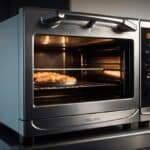Self-cleaning ovens offer a convenient way to tackle the task of oven cleaning without the need for harsh chemical cleaners or significant physical effort. By using high temperatures to burn off food residue and spills, these ovens simplify kitchen maintenance. However, when it comes to operating these appliances in a home with infants, questions regarding safety often arise. I understand that the primary concern for parents is to ensure an environment that is safe and healthy for their babies, one that is free from potential hazards and harmful exposures.

Table of Contents
During a self-cleaning cycle, ovens can reach temperatures well above regular cooking temperatures, which can lead to the production of fumes. In households with children, especially babies, assessing the safety of these emissions is crucial. Babies have smaller lungs and their respiratory systems are still developing, making them more susceptible to airborne irritants. The high heat process utilized by self-cleaning ovens can potentially introduce fine particulate matter into the air, which may not be safe for the delicate respiratory system of infants. It is imperative to take all necessary precautions to minimize any risks that could affect a baby’s health.
Taking into account the potential risks, it’s important to consider proper ventilation, adhering to manufacturer guidelines, and perhaps making alternative arrangements for the baby during the cleaning cycle. Ensuring the safety of self-cleaning ovens in a home with babies involves a combination of understanding the appliance’s operation, recognizing the sensitivity of an infant’s respiratory health, and applying practical safety measures.
Understanding Self-Cleaning Ovens
In sharing my knowledge about self-cleaning ovens, it’s essential I touch on the advanced mechanisms these appliances use to facilitate cleaning, as well as the different types that are available.
Mechanism and Technology
I find that the core technology behind self-cleaning ovens is quite fascinating. They employ a high-heat cleaning method that raises the internal temperature to extremely high levels—typically around 880 to 1000°F (470 to 538°C). During the cleaning cycle, this intense heat works to incinerate food residue and splatters into a fine ash. Some models also offer a steam clean option, which uses heat and water to loosen soil, so it can be wiped away easily after the cycle.
Types of Self-Cleaning Ovens
As I continue to explore this area, it’s clear that there are mainly two types of self-cleaning ovens that utilize different approaches:
- High-Heat Cleaning Ovens
- These ovens use the high temperatures I mentioned to burn off residue. This traditional method is quite effective but can produce odors and smoke.
- Steam Cleaning Ovens
- Steam clean models, which have been gaining popularity, use lower temperatures and add water to create steam that loosens deposits.
Another technology, although less common, is the AquaLift technology, which uses water and low heat to aid in the removal of spills, but this may require some manual cleaning assistance. Each type offers a unique approach to oven maintenance without the need for harsh chemical cleaners.
Safety Concerns and Precautions

In my research and experience, I have identified specific concerns regarding safety while using self-cleaning ovens, especially in households with babies. These concerns include potential hazards from fumes and chemicals, as well as the importance of understanding the safety features built into these appliances.
Potential Hazards During Cleaning Cycles
The self-cleaning cycle of an oven operates at exceptionally high temperatures to incinerate food spills and grease. During this process, it can potentially release fumes and substances that may pose risks:
- Chemicals: The high heat can convert residue from previous spills or cleaners into harmful fumes.
- Carbon Monoxide: Incomplete combustion can produce carbon monoxide, a toxic gas that is dangerous in poorly ventilated spaces.
- Asthma Concerns: Individuals, particularly babies with respiratory issues like asthma, can be sensitive to the toxins released.
- Fire Hazard: Excessive grease accumulation could pose a fire risk if not properly managed before initiating the cleaning cycle.
To mitigate these issues, ensure that the oven is partially cleaned manually to remove larger spills and grease. Also, ventilate the kitchen well by opening windows or using exhaust fans.
Safety Features of Self-Cleaning Ovens
Modern self-cleaning ovens come with several safety features that minimize risks:
- Insulation: Improved insulation helps contain heat and reduce the risk of burns from the exterior surfaces.
- Door Lock: A vital safety feature is the automatic door lock that prevents the oven door from being opened during the cleaning cycle, reducing the danger of burns or exposure to fumes.
Even with these safety mechanisms, it’s advisable to keep children, especially babies, away from the kitchen during a self-clean cycle and to use the feature sparingly in their presence to minimize exposure to any fumes that may be emitted.
Health Implications for Babies and Sensitive Groups

When considering the safety of self-cleaning ovens, it’s crucial to examine the impact these appliances may have on infants and sensitive groups, particularly regarding respiratory health. I’ll guide you through the possible risks and precautions that should be taken to protect the most vulnerable members of your household.
Impact on Infant Respiratory Health
During the self-cleaning cycle, ovens can reach extremely high temperatures to burn off food residue. This process, while effective for cleaning, may release fumes that include carbon monoxide, which could be harmful, especially for babies with weak lungs or existing conditions such as asthma or lung disease. Indeed, I found that these fumes can be a risk to those susceptible to respiratory issues, increasing the potential for ailments like pneumonia and various cold-related symptoms.
Recommendations for Households with Babies
For households with babies, pregnant individuals, or other vulnerable groups, taking precautionary steps is advised to mitigate any risks:
- Ventilate: Increase ventilation by opening windows or using an extractor fan to help dispel any released fumes more rapidly.
- Presence: Ensure that babies and pregnant women are not in proximity to the kitchen during the self-clean cycle.
- Timing: Consider scheduling the cleaning cycle when vulnerable individuals can be out of the home to avoid exposure to potential fumes.
- Alternatives: If concerns persist, manual cleaning methods or non-toxic cleaners offer a safer alternative to high-temperature self-cleaning functions.
By following these guidelines, you can help ensure that your home remains a safe environment for everyone, particularly those most at risk.
Best Practices for Using Self-Cleaning Ovens
When I manage oven maintenance, I prioritize safety, especially with a self-cleaning feature that can reach extremely high temperatures. My goal is to keep the oven clean and reduce the need for frequent self-cleaning cycles, which involve intense heat.
Maintenance and Cleaning Guidelines
Before I initiate a self-cleaning cycle, I make sure to remove all bakeware and racks from my oven. This prevents damage to the racks from the high heat. I always wipe down any large spills or crumbs beforehand to minimize smoke and odors during the cycle. Ventilation is key, so I open windows to keep the area well-ventilated, as the process can sometimes emit fumes that are unpleasant and potentially irritate.
For general maintenance, I also regularly inspect the oven door seal to ensure it is intact, which helps keep heat contained during a self-cleaning cycle. After the cycle is complete and the oven has cooled, I wipe out the ash residue with a damp cloth. It’s important to note that the self-cleaning feature should not be overused; I recommend running it only when necessary, as frequent high-temperature cycles can wear out the oven components more quickly.
Alternative Cleaning Solutions
When deciding on an alternative to the self-cleaning function, I consider safer, less intense options. A simple yet effective mixture I use is baking soda and water to create a paste. I apply it to the interior surfaces and let it sit before scrubbing, which helps to release grime without the need for extreme heat or toxic chemicals.
Another solution I favor involves a mixture of vinegar and water in a spray bottle. After manually cleaning with baking soda, I spritz vinegar over the oven’s interior to react with leftover baking soda residue, which effectively breaks down remaining soil. This method allows me to avoid harsh chemicals while still maintaining a clean oven. Regular manual cleaning can reduce the necessity for the self-cleaning cycle, translating to efficiency in both energy usage and time spent cleaning.









